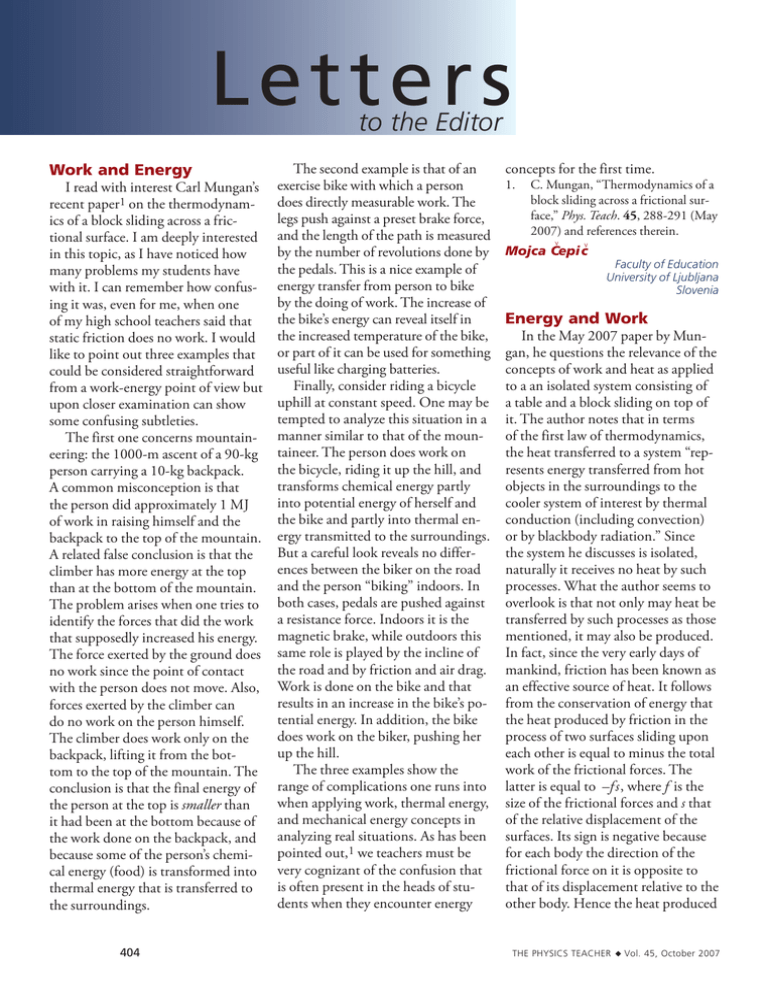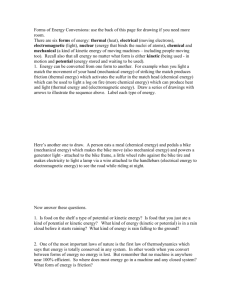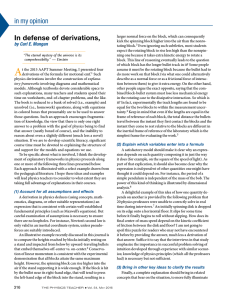Work and Energy
advertisement

Letters to the Editor The second example is that of an I read with interest Carl Mungan’s exercise bike with which a person recent paper1 on the thermodynam- does directly measurable work. The legs push against a preset brake force, ics of a block sliding across a frictional surface. I am deeply interested and the length of the path is measured by the number of revolutions done by in this topic, as I have noticed how the pedals. This is a nice example of many problems my students have with it. I can remember how confus- energy transfer from person to bike by the doing of work. The increase of ing it was, even for me, when one the bike’s energy can reveal itself in of my high school teachers said that static friction does no work. I would the increased temperature of the bike, like to point out three examples that or part of it can be used for something useful like charging batteries. could be considered straightforward Finally, consider riding a bicycle from a work-energy point of view but uphill at constant speed. One may be upon closer examination can show tempted to analyze this situation in a some confusing subtleties. The first one concerns mountain- manner similar to that of the mouneering: the 1000-m ascent of a 90-kg taineer. The person does work on the bicycle, riding it up the hill, and person carrying a 10-kg backpack. transforms chemical energy partly A common misconception is that into potential energy of herself and the person did approximately 1 MJ the bike and partly into thermal enof work in raising himself and the backpack to the top of the mountain. ergy transmitted to the surroundings. But a careful look reveals no differA related false conclusion is that the ences between the biker on the road climber has more energy at the top than at the bottom of the mountain. and the person “biking” indoors. In The problem arises when one tries to both cases, pedals are pushed against a resistance force. Indoors it is the identify the forces that did the work that supposedly increased his energy. magnetic brake, while outdoors this The force exerted by the ground does same role is played by the incline of the road and by friction and air drag. no work since the point of contact with the person does not move. Also, Work is done on the bike and that results in an increase in the bike’s poforces exerted by the climber can tential energy. In addition, the bike do no work on the person himself. does work on the biker, pushing her The climber does work only on the up the hill. backpack, lifting it from the botThe three examples show the tom to the top of the mountain. The conclusion is that the final energy of range of complications one runs into when applying work, thermal energy, the person at the top is smaller than it had been at the bottom because of and mechanical energy concepts in the work done on the backpack, and analyzing real situations. As has been pointed out,1 we teachers must be because some of the person’s chemical energy (food) is transformed into very cognizant of the confusion that is often present in the heads of stuthermal energy that is transferred to dents when they encounter energy the surroundings. Work and Energy 404 concepts for the first time. 1. C. Mungan, “Thermodynamics of a block sliding across a frictional surface,” Phys. Teach. 45, 288-291 (May 2007) and references therein. v v Mojca Cepic Faculty of Education University of Ljubljana Slovenia Energy and Work In the May 2007 paper by Mungan, he questions the relevance of the concepts of work and heat as applied to a an isolated system consisting of a table and a block sliding on top of it. The author notes that in terms of the first law of thermodynamics, the heat transferred to a system “represents energy transferred from hot objects in the surroundings to the cooler system of interest by thermal conduction (including convection) or by blackbody radiation.” Since the system he discusses is isolated, naturally it receives no heat by such processes. What the author seems to overlook is that not only may heat be transferred by such processes as those mentioned, it may also be produced. In fact, since the very early days of mankind, friction has been known as an effective source of heat. It follows from the conservation of energy that the heat produced by friction in the process of two surfaces sliding upon each other is equal to minus the total work of the frictional forces. The latter is equal to –f s, where f is the size of the frictional forces and s that of the relative displacement of the surfaces. Its sign is negative because for each body the direction of the frictional force on it is opposite to that of its displacement relative to the other body. Hence the heat produced The Physics Teacher ◆ Vol. 45, October 2007 Letters is equal to f s, and the sliding process satisfies the first law. In the first instance, the frictional heat is deposited in the immediate surroundings of the sliding interface, where it gives rise to a local increase of temperature. It is transferred subsequently by heat conduction to the entire system. At thermal equilibrium, it becomes distributed on the individual components of the system in proportion to their heat capacities. Mungan calculates each of the two bodies’ share of the deposited heat and notices that these shares do not balance. Of course they do not. Both of them are positive. And they should not because their origin in the first instance is not heat conduction but heat production. Mungan suggests that in the process he discusses, individual calculation of heat and work may only be done microscopically. This is not true. Providing that the size of the frictional force is known, we can calculate the kinematics of the bodies and hence the total work of the frictional forces. From that we get the heat produced just by a change of sign. Thus, contrary to the author’s opinion, the individual concepts of heat and work are in my view highly relevant to this process. Kai Neergård Naestved Gymnasium og HF Nygårdsvej 43 4700 Naestved, Denmark kai@kaineergard.dk Author’s Response Nowadays it is conventional to distinguish energy transferred by thermal conduction or radiation from thermal energy acquired by an object, rather than referring to both as heat as was done historically.1 However, the essential thing is to be able to calculate the changes in the values of all relevant state variables (temperature, The Physics Teacher ◆ Vol. 45, October 2007 pressure, energy, entropy, velocity, and so on) and this has been my emphasis throughout my writings.2 Too much “energy” has gone into arguing about the definitions of heat and work, rather than into solving interesting problems in mechanics and thermodynamics. Kai’s letter reinforces my view that introducing the notions of heat and work in discussions of dissipative processes often detracts from this bottom line by diverting one’s attention to semantics. Even if one can self-consistently introduce these notions, it is not necessary to do so, nor does it simplify any practical calculations, so why bother? them to investigate the behavior of static friction. I’d never seen this sort of data presented before, so I thought it would be interesting to see what could be extracted from them. The estimate I am making here will be somewhat crude, so I will only carry one significant figure. We are provided with only limited information about the wooden block that was used in the experiment described. Let us take it to have a density r = 1000 kg/m3, typical for woods. As we are told that the weight of the block is 8.00 N, we can take its mass to be ~0.8 kg and thus its volume to be ~8310-4 m3. If we take the block to be cubical, an edge would have a 1. Contrast Feynman’s statement length of ~0.09 m; we will take this from the early 1960s that “we have as a characteristic size for the block. converted work into heat” in the The face of the block in contact with middle of page 44-3 of Volume I of the horizontal wooden plane then The Feynman Lectures on Physics with has a surface area of ~0.009 m2. Arons’s warning in December 1999 This next part will be the coarsest against this very same wording at the part of the calculation, since wood end of page 1065 of Am. J. Phys. 67. is not a uniform substance. We will 2. Examples include the sudden comtake its principal molecular compopression of an insulated ideal gas nent to be cellulose, which is actually in Phys. Teach. 41, 450–453 (Nov. 2003), the efficiency of laser cooling a polymer of glucose (C6H10O5)n , where n can run into the thousands; in Am. J. Phys. 73, 315–322 (April the molecular weight of a monomer 2005), and mechanical systems is then ~160 amu. The number of of rolling without slipping and of masses connected by a spring in these monomers in the block is on Phys. Teach. 43, 10–16 (Jan. 2005). the order of Although one can take issue with the ( 800 g / 160 g/mole) . N ~ 331024. A details of my definitions of heat and Were they spread uniformly throughwork, they enable one to solve probout the block, the number of monolems efficiently and accurately. mers on the contact face would Carl E. Mungan be ~( 331024)2/3 ≈ 231016. A U.S. Naval Academy Annapolis, MD 21402 comparable number would be presmungan@usna.edu ent in the region of contact of the wooden plane, so this number is also an estimate of the number of interInterferometric Measure- molecular bonds formed. (Note that ment of Displacements this number also leads us to a size I recently came across the interestestimate for the monomers of ing article by Alanis et al.1 on laser 0.09 m/( 331024 )1/3 ≈ 0.6 nm, interferometric measurement of which is roughly in the proper microscopic displacements, used by range.) 405









